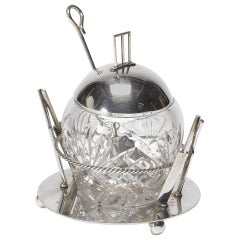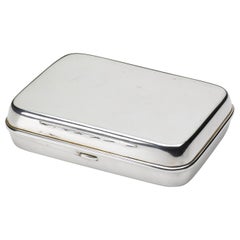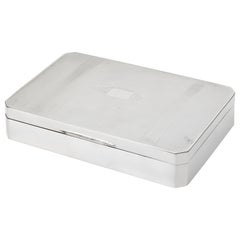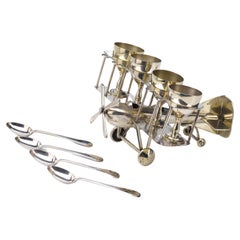Want more images or videos?
Request additional images or videos from the seller
1 of 2
Sheffield Silver Hunting Rifle Toast Rack, Circa 1900
Price:$500
$695List Price
About the Item
- Dimensions:Height: 6 in (15.24 cm)Width: 2 in (5.08 cm)Depth: 7.5 in (19.05 cm)
- Period:
- Date of Manufacture:1900-1920
- Condition:Wear consistent with age and use.
- Seller Location:Colorado Springs, CO
- Reference Number:1stDibs: LU90973215972
About the Seller
4.9
Vetted Professional Seller
Every seller passes strict standards for authenticity and reliability
Established in 2010
1stDibs seller since 2011
464 sales on 1stDibs
Authenticity Guarantee
In the unlikely event there’s an issue with an item’s authenticity, contact us within 1 year for a full refund. DetailsMoney-Back Guarantee
If your item is not as described, is damaged in transit, or does not arrive, contact us within 7 days for a full refund. Details24-Hour Cancellation
You have a 24-hour grace period in which to reconsider your purchase, with no questions asked.Vetted Professional Sellers
Our world-class sellers must adhere to strict standards for service and quality, maintaining the integrity of our listings.Price-Match Guarantee
If you find that a seller listed the same item for a lower price elsewhere, we’ll match it.Trusted Global Delivery
Our best-in-class carrier network provides specialized shipping options worldwide, including custom delivery.You May Also Like
John Round Sheffield Aesthetic Movement Silver Plate Fan Shaped Toast Rack
Located in Bishop's Stortford, Hertfordshire
An unusual large English Aesthetic Movement silver plate toast or muffin rack by John Round & Son of Sheffield and dated 1887. The rack stands on four square cut corner feet adjoined...
Category
Antique 1880s English Aesthetic Movement Serving Pieces
Materials
Silver Plate
$758
Free Shipping
H 5.91 in W 7.68 in D 2.86 in
Art Deco Silver Toast Rack, 4 Slice Breakfast Bread Stand With Handle Sheffield
Located in Wembley, GB
A lovely petite English silver plated four-slice toast rack. This fine quality Sheffield silver toast rack is well made with a stunning Art Deco style geometric shape and decorative ...
Category
Vintage 1920s British Art Deco Sheffield and Silverplate
Materials
Silver, Silver Plate, Sterling Silver
$397 Sale Price
20% Off
Free Shipping
H 5.52 in W 7.09 in D 4.73 in
Art Deco Style English Silver Plate Toast Rack
Located in Pearland, TX
A stylish vintage English silverplated six slice toast rack. No maker's mark. This fine quality silver toast rack is well made with a lovely Art Deco style trefoil design and charmin...
Category
Mid-20th Century English Sheffield and Silverplate
Materials
Silver Plate
Art Deco English Silver Toast Rack, 4 Slice Breakfast Bread Car Shape Toast Bar
Located in Wembley, GB
A lovely petite English silver plated four-slice car-shaped toast rack. This fine quality silver toast rack is well made with a lovely Art Deco style geometric shape and decorative f...
Category
Vintage 1920s British Art Deco Sheffield and Silverplate
Materials
Silver, Silver Plate, Sterling Silver
$523 / item
Free Shipping
H 5.52 in W 6.3 in D 5.12 in
Antique Sheffield Electroplated Table Cigar Lighter, Circa 1900
By John Edward Bingham (Walker and Hall)
Located in West Hollywood, CA
Antique Sheffield Electroplated Table Cigar Lighter
This unique and collectible piece features a dragon design with an unscrewing head, meticulously crafted by Walker & Hall around 1900. The body is made from the horn of an Indian blackbuck antelope, adding to its exotic charm and historical value. This Sheffield electroplated cigar lighter is not just a functional item but a statement piece for any collector or enthusiast of antique smoking accessories.
Category
Antique Early 1900s British Sheffield and Silverplate
Materials
Silver, Sheffield Plate
Antique English Sheffield Silver Goblet, circa 1890
Located in New Orleans, LA
Antique English Sheffield silver goblet, circa 1890.
GOB004
Category
Antique Late 19th Century English Sheffield and Silverplate
Materials
Silver Plate
Antique English Sheffield Silver Goblet, circa 1880
Located in New Orleans, LA
This is an attractive goblet and has room for engraving if desired.
Category
Antique Late 19th Century English Barware
Materials
Silver Plate
Copeland Toast Rack Silverplate, c1860s, England
Located in Litchfield, CT
Circa 1860s, Silverplate, by Copeland, England. Wonderfully unusual, this gorgeous toast rack by Copland is an Art Deco pre-curser. Think Dr, Dresser meets William Morris. Perfect fo...
Category
Antique 1860s Sheffield and Silverplate
Materials
Silver Plate
Sheffield Silver Tray
Located in New York, NY
Oval flower pattern silver salver tray with embossed grape pattern border. Raised on scroll shaped feet. Sheffield silver, circa 1845.
Category
Antique 19th Century English Sheffield and Silverplate
Materials
Silver
vintage Italian Swan Toast Rack, Silver-Plated, 1970s – Elegant and Versatile
Located in Hamburg, DE
This exquisite vintage toast rack, designed in the shape of a graceful swan, was crafted in Italy in the 1970s. Made from silver-plated metal, it features a delightful blend of elega...
Category
Vintage 1970s Italian Hollywood Regency Sheffield and Silverplate
Materials
Metal
$289
H 3.94 in W 6.3 in D 3.15 in
More From This Seller
View AllSilver Sheffield Cricket Sugar Jar, circa 1900
Located in Colorado Springs, CO
This is an exquisite early 20th century crystal jar with a silver lid and spoon. The lid's top is fashioned after a cricket wicket. The jar sits on a round silver base with decorativ...
Category
Antique Early 19th Century British Sheffield and Silverplate
Materials
Silver
Hallmarked Silver Plated Keepsake Box, Sheffield, Uk, Circa 1900
Located in Colorado Springs, CO
Offered is a stunning Sheffield silver keepsake box dating to 1900, with associated hallmark. This small box includes a clean interior and rounded corners. The box is free of names or initials, but would have been used to house keepsakes such as jewelry or cufflinks. A well maintained, elegant piece, this antique silver box is an excellent addition to any silver collection.
Trinket or keepsake boxes have taken on many forms since their first conception in ancient times. However their purpose remains the same; to store jewelry and other items precious to the owner. Originally, these boxes were used specifically for jewelry. These were in common use as early as 5000 BC in Ancient Egypt, when the majority of Egyptians, both male and female, wore jewelry. Boxes were used to keep these gemstone encrusted items safe. In Ancient Rome, jewelry was a status symbol. Rings and brooches were utilized to represent ones status in society. Again, boxes were needed for security and storage purposes. Finding early examples of these are quite rare.
Victorian and Edwardian examples of trinket boxes are far more common. This is because owning jewellery was a luxury until the Victorian era- let alone possessing so much a box was needed to store it all. Fine jewelry and other items became available to the masses after the industrial revolution due to the reduction in production costs. This led to a demand for trinket boxes, which were much smaller than jewelry boxes and therefore better suited to the needs of the middle class who did not yet possess an abundance of jewelry.
In Victorian households, collectables and other items of interested were also stashed inside these boxes. This is why they are known as trinket or keepsake boxes, rather than just jewelry boxes, although of course jewelry was also stored in them. Trinket boxes were produced in large numbers around this time. Many were lined with colored plush or velvet or rich wood. More elaborate designs had interior divisions and trays for rings and other pieces of jewellery. It was also common to see trinket boxes so small that they could only contain one item, such as a single ring. Ornate exteriors were created to reflect the value of the trinket boxes contents.
The Edwardian era saw the introduction of new styles of trinket box. These included small circular or oblong boxes...
Category
Antique Early 1900s British Art Deco Decorative Boxes
Materials
Silver
Hallmarked Silver Plated Keepsake Box, Sheffield, UK, circa 1900
Located in Colorado Springs, CO
Offered is a stunning silver plated keepsake box dating to 1900, with associated hallmark. This small box includes a wooden interior with two slots and a blank square on top where initials could have been engraved. A well maintained, elegant piece, this antique silver box is an excellent addition to any silver or home decor collection.
Trinket or keepsake boxes have taken on many forms since their first conception in ancient times. However their purpose remains the same; to store jewelry and other items precious to the owner. Originally, these boxes were used specifically for jewelry. These were in common use as early as 5000 BC in Ancient Egypt, when the majority of Egyptians, both male and female, wore jewelry. Boxes were used to keep these gemstone encrusted items safe. In Ancient Rome, jewelry was a status symbol. Rings and brooches were utilized to represent ones status in society. Again, boxes were needed for security and storage purposes. Finding early examples of these are quite rare.
Victorian and Edwardian examples of trinket boxes are far more common. This is because owning jewellery was a luxury until the Victorian era- let alone possessing so much a box was needed to store it all. Fine jewelry and other items became available to the masses after the industrial revolution due to the reduction in production costs. This led to a demand for trinket boxes, which were much smaller than jewelry boxes and therefore better suited to the needs of the middle class who did not yet possess an abundance of jewelry.
In Victorian households, collectables and other items of interested were also stashed inside these boxes. This is why they are known as trinket or keepsake boxes, rather than just jewelry boxes, although of course jewelry was also stored in them. Trinket boxes were produced in large numbers around this time. Many were lined with colored plush or velvet or rich wood. More elaborate designs had interior divisions and trays for rings and other pieces of jewellery. It was also common to see trinket boxes so small that they could only contain one item, such as a single ring. Ornate exteriors were created to reflect the value of the trinket boxes contents.
The Edwardian era saw the introduction of new styles of trinket box. These included small circular or oblong boxes...
Category
Antique Early 1900s English Art Deco Decorative Boxes
Materials
Silver
$600 Sale Price
20% Off
Silver Plated Airplane-Themed Tableware, circa 1910
Located in Colorado Springs, CO
This is a beautiful silver-plated egg cup and spoon set with an airplane motif, dating to the early 1910s. The set includes four matching footed egg cups. The cups sit upon the stack...
Category
Vintage 1910s English Art Deco Sheffield and Silverplate
Materials
Silver
Douglas Adams Signed Antique Print, Hunting Scene, Artist Proof, circa 1893
By Douglas Adams
Located in Colorado Springs, CO
This is the artist proof edition of an untitled hunting scene by Douglas Adams. The print was issued in a limited, numbered edition of 300 and is signed by the artist in the margin. ...
Category
Antique 1890s British Prints
Materials
Paper
Two Hunting Dogs Bronze Sculpture
Located in Colorado Springs, CO
Presented is a bronze sculpture of two hunting dogs. One dog is depicted with his nose to the ground, having caught the scent of the hunt. The other dog p...
Category
20th Century Sculptures and Carvings
Materials
Bronze
Recently Viewed
View AllMore Ways To Browse
English Silver Toast Rack
English Toast Racks
Toast Plate
English Plate Rack
Sheffield Toast Rack
Silver Rifle
Cruet Bottles Antique
Ellis Barker Silver Plate
Meriden Silver Plate
Antique Sheffield Silver Plate Tea Service
Antique Silver Ingot
Silver Plated Butter Dish
Sheffield Dome
Sheffield Epergne
Sheffield Silver Dome
Silver Plated Samovar
Silverplate Coffee Service
Vintage Christofle



